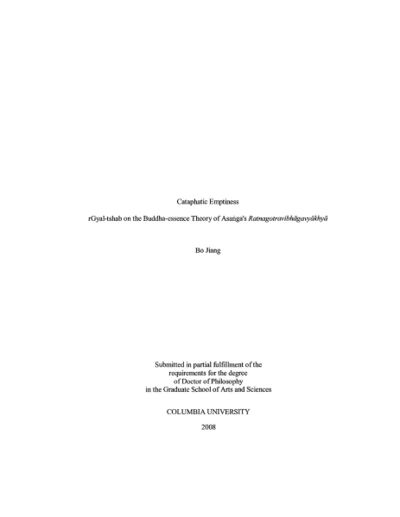Cataphatic Emptiness: rGyal-tshab on the Buddha-essence Theory of Asaṅga's Ratnagotravibhāgavyākhyā
< Books
| Line 16: | Line 16: | ||
*{{i|Technical Notes|vii}} | *{{i|Technical Notes|vii}} | ||
| − | Part | + | Part 1: The Prāsaṅgika-Mādhyamika Interpretation of the Buddha-essence Theory |
*{{i|Introduction|2}} | *{{i|Introduction|2}} | ||
*{{i|Chapter 1: Historical and Doctrinal Background|17}} | *{{i|Chapter 1: Historical and Doctrinal Background|17}} | ||
| Line 91: | Line 91: | ||
***{{i|Unchangeability|200}} | ***{{i|Unchangeability|200}} | ||
***{{i|Indivisible excellences|205}} | ***{{i|Indivisible excellences|205}} | ||
| + | *{{i|Chapter 7: The Eighteen Similes in the ''Tathāgatagarbha-sūtra''|209}} | ||
| + | **{{i|1. rGyal-tshab's General Discussion|209}} | ||
| + | **{{i|2. The Nine Smiles for the Obscuring Defilements|215}} | ||
| + | ***{{i|The lotus simile for latent state of attachment|215}} | ||
| + | ***{{i|The bees simile for latent state of hatred|216}} | ||
| + | ***{{i|The husks simile for latent state of misknowledge|216}} | ||
| + | ***{{i|The filth simile for intense outburst of attachment, hatred, and misknowledge|218}} | ||
| + | ***{{i|The floor simile for ground of instincts for misknowledge|219}} | ||
| + | ***{{i|The fruit simile for addictions eliminated by the Path of Insight|220}} | ||
| + | ***{{i|The tattered rags simile for addictions eliminated by the Path of Meditation|221}} | ||
| + | ***{{i|The woman simile for addictions related to the Impure Stages|222}} | ||
| + | ***{{i|The clay simile for addictions related to the Pure stages|223}} | ||
| + | ***{{i|Discussion of the twofold obscuration|224}} | ||
| + | **{{i|3. The Nine Smiles for the Obscured Element|226}} | ||
| + | ***{{i|The three similes for the Truth Body|228}} | ||
| + | ***{{i|The gold simile for reality|230}} | ||
| + | ***{{i|The five similes for the spiritual gene|231}} | ||
| + | *{{i|Chapter 8: The Twofold Spiritual Gene|236}} | ||
| + | **{{i|1. Tsong-kha-pa's Analysis of the Vijñānavadin Standpoints|237}} | ||
| + | **{{i|2. A Mādhyamika Critique of the Vijñānavadin Standpoint|248}} | ||
| + | **{{i|3. The dGe-Iugs-pa Exegesis of the "Spiritual Gene" Section of the AA|250}} | ||
| + | **{{i|4. Natural Luminosity of the Mind under Debate|256}} | ||
| + | *{{i|Conclusion|264}} | ||
| + | *{{i|Abbreviations|268}} | ||
| + | *{{i|Bibliography|271}} | ||
| − | **{{i|A. The | + | Part 2: Appendices |
| − | **{{i|B. The ''Theg pa chen po rgyud bla ma'i ṭīkā'' (Chapter One: | + | *{{i|1. A Special Edition of Chapter One of the ''Theg pa chen po rgyud bla ma'i ṭīkā'' (1a-72a and 64a-170b)|285}} |
| + | **{{i|A. Topical Outline|285}} | ||
| + | **{{i|B. Special Edition|306}} | ||
| + | *{{i|2. Translations|449}} | ||
| + | **{{i|A. The ''Mahāyānottaratantrarvyākhyā'' (Chapter One: 1.1-7.5 and 21.1-78.22)|449}} | ||
| + | **{{i|B. The ''Theg pa chen po rgyud bla ma'i ṭīkā'' (Chapter One: 1a-72a and 64a-170b)|525}} | ||
|AddRelatedTab=No | |AddRelatedTab=No | ||
}} | }} | ||
Revision as of 16:50, 30 April 2020
Abstract
This doctoral dissertation studies the Ratnagotravibhāga (Uttaratantra), the only surviving Indian Buddhist treatise on the Buddha-essence doctrine, by way of one of its major Tibetan commentaries, rGyal-tshab Dar-ma-rin-chen (1364-1432)'s Theg pa chen po rGyud bla ma'i ṭīkā. This project consists of three parts: a special edition of the first chapter of the Theg pa chen po rGyud bia ma'i ṭīkā, an English translation of the selected sections of that commentary, and a comparative analysis which follows six distinct lines of inquiry.
The six lines are: rGyal-tshab's doctrinal classification of the text; his critiques of absolutism, skepticism, and quietism in connection with diverse interpretations of the Buddha-essence doctrine in Tibetan traditions as well as a tentative comparison with critiques of the theory of "Original-enlightenment" in modern Chinese Buddhism; his analysis of the title of Tibetan version and the structure of the text; rGyal-tshab's
philosophical positions on reality, Element, and natural luminosity of the mind; his expositions of the tripartite Buddha-essence, its ten aspects, and the eighteen similes; and the notion "spiritual gene" understood by dGe-lugs-pas.
This comparative approach will provide a broader synthetic understanding of the role that Buddha-essence played as a doctrinal genre in Tibetan intellectual history.
| Citation | Jiang, Bo. "Cataphatic Emptiness: rGyal-tshab on the Buddha-Essence Theory of Asaṅga's Ratnagotravibhāgavyākhyā." PhD diss., Columbia University, 2008. |
|---|---|

